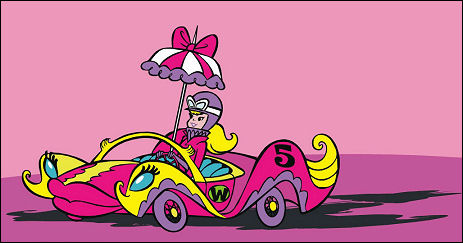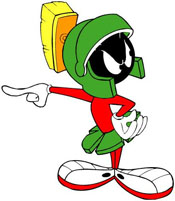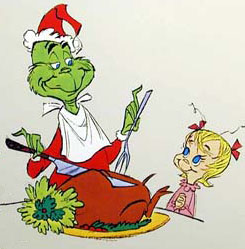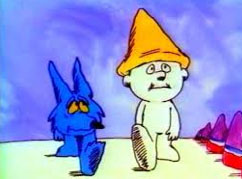
Designing Penelope Pitstop. The female Wacky Racer Penelope Pitstop was a last minute addition to the cast.
“I remember sitting in my office while Joe (Barbera) was in a meeting with programming executives,” recalled Hanna-Barbera designer Iwao Takamoto. “Someone apparently mentioned that there was one thing missing in ‘The Wacky Races’ (1968) show. There was no female character!
“Joe came charging down to my office and said, ‘Just do anything. Give me a female racing driver that will fit into ‘The Wacky Races’.’ So I just did everything I could to her, including giving her the car, since that was the concept of the show. It was a real corn dog of a car with all these feminine features.
“Two hours later, Joe comes charging back asking me if I had anything. They must have liked her enough, because the show was sold.”
Penelope with her Compact Pussycat racer was so popular that she was later spun off into her own series, “The Perils of Penelope Pitstop” (1969) with the Ant Hill Mob from “The Wacky Races” as well saving her from The Hooded Claw (who strangely had neither a hood nor a claw).

Designing Scooby Doo. How did talented designer Iwao Takamoto come up with the designs for the cast of Scooby Doo?
“I’d mainly work in coordination with Joe (Barbera). When it came to designing the characters, he and I would kick some ideas back and forth. We’d basically examine how the characters would work in the entertainment aspects of the stories. I’d take that and develop the look of the characters.
“Fred was the voice of reason. Daphne wasn’t a dummy. She was a girl that did everything off the top of her head. Velma wasn’t nerdy. She was just bright. An intellectual. As for the glasses, it was a cheap way to do it, but I felt that if she’s an intellectual she should wear glasses. Shaggy is just…shaggy. The beatnik.
“Scooby Doo embodied the exact opposite of a prize-winning Great Dane. As luck would have it, there was a woman in the office who raised prize-winning great danes. I had her physically describe a champion great dane to me and used that as the basis for Scooby. If a champion dane had hind quarters that were straight, I made Scooby bow-legged. If a champion dane had a strong square chin, I gave Scooby a weak chin. It was that kind of approach.”
Iwao’s Inspiration. Where did Hanna-Barbera character designer Iwao Takamoto get his ideas? From observing people. “In the early days at Hanna-Barbera, I used to love during lunch to go down to someplace like Hollywood Boulevard and just watch the people,” Takamoto said. “There used to be a bookshop called The Pickwick. Everyday, so many people would congregate there. It was a great place to look at people. There would be everything from the homeless to business executives to hookers.”
 Why Does Marvin Martian Wear Keds? According to animation legend Chuck Jones who introduced Marvin Martian in “Haredevil Hare” (1948), the character wears Keds because when Jones was a child, sneakers made him feel like he could jump higher, run faster and be invincible, even defying the laws of gravity. The pseudo-Roman helmet and outfit was to signify the Roman God of War, Mars.
Why Does Marvin Martian Wear Keds? According to animation legend Chuck Jones who introduced Marvin Martian in “Haredevil Hare” (1948), the character wears Keds because when Jones was a child, sneakers made him feel like he could jump higher, run faster and be invincible, even defying the laws of gravity. The pseudo-Roman helmet and outfit was to signify the Roman God of War, Mars.
“That was the uniform that Mars wore — that helmet and skirt,” Jones shared with me in an interview. “We thought putting it on this ant-like creature might be funny. But since he had no mouth, we had to convey that he was speaking totally through his movements. It demanded a kind of expressive body mechanics.”
 Cindy Lou Who. While animation legend Chuck Jones always contended that the design of Cindy Lou Who in “How the Grinch Stole Christmas” (1966) was supposedly modeled after his own granddaughter, Valerie, in 1996, he told an interviewer that “As for Cindy Lou Who, she was appealingly small and innocent. I drew her as seeming to be a great-grandchild of the Grinch in appearance—a diminutive Grinch, where everything is right where the Grinch is wrong.”
Cindy Lou Who. While animation legend Chuck Jones always contended that the design of Cindy Lou Who in “How the Grinch Stole Christmas” (1966) was supposedly modeled after his own granddaughter, Valerie, in 1996, he told an interviewer that “As for Cindy Lou Who, she was appealingly small and innocent. I drew her as seeming to be a great-grandchild of the Grinch in appearance—a diminutive Grinch, where everything is right where the Grinch is wrong.”
Boris Triumphs. During the taping of the narration for “How the Grinch Stole Christmas” (1966), actor Boris Karloff was quite ill and would pass away a little more than two years later. His emphysema had him wheezing badly and his back and legs were giving him great pain.
A friend of Ted Geisel’s (Dr. Suess) was visiting the set that day. He was a well known cardiologist and as he watched Boris struggle, he went to Geisel and said, “That is a very sick man. I don’t know how he will be able to last through this.”
As Geisel remembered, “It was an exhausting day. Everything went wrong. At the end of the day, we were all wilted…except Boris. As we dragged ourselves off, he left whistling.”
Karloff later received a Grammy Award for “Best Recording For Children” after the Seuss story was released as a record.
Not Coming Attractions. In 1985, Disney announced it was considering that its next animated feature film would be “Thumper: The Motion Picture”. The character of Thumper does not appear in the original novel by Felix Salten but Disney executives felt it was a good idea because it featured a beloved famous character so it would have strong merchandising potential as well as nostalgic appeal. At the same time, Disney was also seriously considering “Catfish Bend” based on the books by Ben Lucien Burman about a group of swampland animal characters. Disney Legend Ken Anderson had worked on character designs for the characters as early as the mid-1970s. Interestingly, Filmation announced it was considering making an animated feature entitled “The Son of the Sleeping Beauty” followed by a string of other sequels based on public domain characters like Pinocchio that had been in Disney animated features.
 Get the Point? In 1971, Brooklyn born Harry Nilsson wrote the music and story for a seventy-four minute animated ABC television special entitled “The Point”. It was the story of Oblio, a round headed child where people, and just about everything else, had a point. Animation was done by Murakami-Wolf Productions.
Get the Point? In 1971, Brooklyn born Harry Nilsson wrote the music and story for a seventy-four minute animated ABC television special entitled “The Point”. It was the story of Oblio, a round headed child where people, and just about everything else, had a point. Animation was done by Murakami-Wolf Productions.
In 1977, Ron Pember and Bernald Miles adapted the story into a stage play that was performed in London at the Mermaid Theater. The show followed the original story reasonably closely and was staged by projecting kaleidoscopic images onto diamond-shaped screens which interchanged to conceal and reveal scenery changes. Former members of The Monkees, Davy Jones and Mickey Dolenz performed as Oblio and Count’s Kid. They were both long time friends of Nilsson.
More Animation Anecdotes are available in a new book compiled by Jim Korkis. It’s available now via amazon or publisher Theme Park Press.


 Jim Korkis is an internationally respected animation historian who in recent years has devoted his attention to the many worlds of Disney. He was a columnist for a variety of animation magazines. With his former writing partner, John Cawley, he authored several animation related books including The Encyclopedia of Cartoon Superstars, How to Create Animation, Cartoon Confidential and Get Animated’s Animation Art Buyer’s Guide. He taught animation classes at the Disney Institute in Florida as well as instructing classes on acting and animation history for Disney Feature Animation: Florida.
Jim Korkis is an internationally respected animation historian who in recent years has devoted his attention to the many worlds of Disney. He was a columnist for a variety of animation magazines. With his former writing partner, John Cawley, he authored several animation related books including The Encyclopedia of Cartoon Superstars, How to Create Animation, Cartoon Confidential and Get Animated’s Animation Art Buyer’s Guide. He taught animation classes at the Disney Institute in Florida as well as instructing classes on acting and animation history for Disney Feature Animation: Florida.




















































Seems like the idea of featuring Thumper was pushed on many fronts during the early Eisner years. I recall a JHM article that mentioned an idea floating around of Thumper getting his own series on television.
There actually was a “Thumper Meets The Seven Dwarfs” comic book, published in the 1940’s by Dell.
This is an outstanding issue, Jim!
Eric Larson was the true champion of Ben Lucien Berman’s “Catfish Bend” series, he tried to get them adapted and in development for years and years.
I wonder — do the “swampland animal characters” in 1977’s THE RESCUERS bear any resemblance to Anderson’s “Catfish Alley” designs from the same period?
Beverly D’Angelo has stated in interviews that Penelope Pitstop was modeled after her, as she was employed at H-B at the time.
She must have looked silly showing up to work every day wearing a helmut and goggles! 😉
Filmation actually released two quasi-sequels, “Happily Ever After” (Snow White) and “Pinocchio and the Emperor of the Night”.
Also remember an early DVD release of “Dumbo” had a featurette promoting the video sequel to that film . . . which never happened.
Filmation also did a TV special, “A Snow White Christmas” wherein Snow White’s daughter met the “Seven Friendly Giants.”